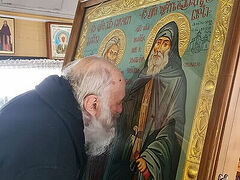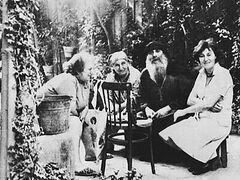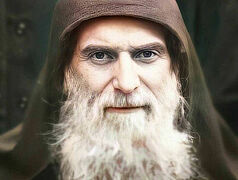A little Soviet boy heard the word “crucify”, and could not understand what it meant. He lived in a communist country, and only the caretaker of a closed church showed him a crucifix with the Savior... The boy played at church, then went into seclusion, misunderstood by his family, people around him, and peers... At the age of twenty-five, he took monastic vows... He would go to garbage dumps, and built a church out of materials at hand in the courtyard of his house. Then came an act incomprehensible to anyone and a very bold challenge to idolatry—he burned a huge portrait of Lenin in front of a thousand people... Then he went through prison, a psychiatric hospital, beatings, mocking... And the culmination of his spiritual labors was reviving Orthodoxy in Georgia bit by bit... He cut a clipping from the Ogonyok (“Spark”) magazine with an image of Andrei Rublev’s “Trinity” Icon and hung it on the church wall; he kept a photograph of the Royal Martyrs at his cell; and he preached Christ everywhere—in every corner—even in the mental hospital, in prison, in a beerhouse, on Rustaveli Avenue... And, of course, there were posthumous miracles—not only in Georgia, but throughout the Orthodox world...
 The elder was also a “fool-for-Christ”. He did not seek human praise and did not pay attention to the fact that many did not accept him; on the contrary, he rejoiced, humbled himself and taught everyone humility. Many clergy and laity went through his “school”, and they unanimously note:
The elder was also a “fool-for-Christ”. He did not seek human praise and did not pay attention to the fact that many did not accept him; on the contrary, he rejoiced, humbled himself and taught everyone humility. Many clergy and laity went through his “school”, and they unanimously note:
“He had big, kind eyes. And even when he denounced us, shouted and got angry with us, those kind eyes always betrayed him. They radiated love and compassion, and we could read in his eyes, ‘Child, I’m doing all this for you. For your enlightenment.’ There was not a single minute when Fr. Gabriel did not think about God. He saw the image of God in every person and did not single out anyone.”
Why did almost all the inhabitants of Georgia learn about him so quickly after the elder’s repose? His cell-attendant, Nun Parasceva (Rostiashvili), recalls the first miracle at the grave of Elder Gabriel:
“On the third day after Fr. Gabriel’s death, a woman whose only son had disappeared a month before came to Samtavro. She did not know that the elder was dead, but when I saw how worried she was I advised her to go to his grave and pray, talking to him as if he were alive, offering up her petition. So she did. Three days later, the happy mother reappeared and said that her son had returned home, safe and sound. That was the first miracle that occurred at the grave of Fr. Gabriel. At first I did not pay any attention to it, but then people started to share other stories, and I began to write them down. Then there were a lot of them. After some time, I placed a large icon lamp on his grave so that it would burn perpetually, and people could anoint themselves and take oil. And it has been so ever since. People who came to the convent for help and consolation said that after they had visited Elder Gabriel’s grave all their troubles and temptations quickly disappeared.”
Every time I look at the smiling, kind image of Father Gabriel, I clearly recall the day when I first “met” him. It was a long time ago. In 2003, from Western Georgia we went to Mtskheta on an excursion. Holding my grandmother by the hand, I did not walk away from her and was afraid of getting lost. When I saw so many people at the elder’s grave who bowed down, took off their crosses, rings and laid them on the ground, I was amazed and asked the adults, “Who is buried there?” I was told that it was Father Gabriel who loves everyone, especially children, and works miracles for the glory of God. I remember running up to the grave, kneeling down and saying to batiushka, “It’s great that you exist. I study well, I don’t offend my parents. You are so kind! May you rest in peace, Grandfather Gabriel.” Back then I could not have imagined that I would be first the translator of a book into Russian, and then the author of documentaries and books about him. Elder Gabriel has worked so many miracles for me, and with how many wonderful people he has brought me together! I cannot help but recall my meeting with the reposed Archbishop Alexander (Ishchein; 1952–2021) of Baku and Azerbaijan. He met Father Gabriel in his lifetime:
“We went to the elder. He lived in a special cell—in fact, these were the remains of an ancient tower. Once we crossed the threshold of his cell and said a prayer, the elder suddenly began to move energetically around the cell, while repeating the following words: ‘No matter how much you run—first running away and then running back—you won’t run anywhere from Baku.’ At that time, I had the desire in my heart to return to the North Caucasus—to the Stavropol Diocese where my pastoral ministry had begun. I at once realized that those words were about me. I returned to Baku, after which I was again transferred to the Stavropol Diocese; and suddenly our ruling hierarch, the reposed Metropolitan Gedeon (Dokukin; 1929-2003), invited me back and said that there was such a proposal... And I had no choice but to response: ‘I return thanks, and accept, and say nothing contrary thereto.’ The words of Elder Gabriel, who proclaimed God’s will to me, came true.”
I am grateful to His Holiness Catholicos-Patriarch Ilia II for the fact that, since he was devoted to Elder Gabriel in the latter’s lifetime, the Lord gave him the strength to canonize him.
Shortly after Elder Gabriel’s canonization, on February 22, 2014, his holy relics were uncovered. There is nothing like this event in the recent history of the Georgian Church. An astounding number of people were present at the exhumation of his holy body. People from all over the world came to venerate the elder’s relics. Due to the large number of believers, the relics were transferred to the Holy Trinity Cathedral in Tbilisi.
The love of Elder Gabriel embraced all the people who came to him in those blessed moments when all of Georgia and the entire Orthodox world stood all night long at Elder Gabriel’s shrine and became eyewitnesses of many miracles, when services were going on nonstop, akathists were read, and the faithful glorified and hymned our Lord Jesus Christ and the Most Holy Theotokos, feeling the presence of the grace of the Holy Spirit and the Venerable Elder Gabriel.
His Holiness Catholicos-Patriarch Ilia II addressed the flock with the following words:
“Both believers and non-believers very often ask the question: ‘What is happiness?’ What is happening in Georgia today is happiness. Today the sun is shining over our country… This is the coming of the Holy Spirit, our transformation. This is exactly the state when good reigns and evil is expelled. This is forgiveness and mutual love... Elder Gabriel has brought all of this into our lives. One man has changed the whole of Georgia...
“We give thanks to the Lord and Father Gabriel for this great blessing... This is a sign of the salvation of our nation, a guarantee of our happy future... Today Elder Gabriel is blessing all of Georgia. All of this is a great happiness.”
It is indeed a great happiness. And do you know why? Because at the right moments the elder helps us all. He was canonized in 2012, and as early as 2014 his grave was opened. He fell asleep in the Lord in 1995. He is our contemporary. Many people who knew him well are still alive. Many doubted whether he should be canonized or not, because even the greatest saint of our times, St. Seraphim of Sarov, was canonized seventy years after his repose. But Patriarch Ilia, like St. Nicholas II before him, put an end to the arguments and canonized him.
Elder Gabriel transformed my life and showed me that the most important things are love and humility. While working on films about him, I was naturally inspired with the great love that our Elder Gabriel bore. I saw with my own eyes what the power of God and Elder Gabriel’s prayers can do. And in the film, I talked about how a young man who had been dumb for nine years began to speak at his holy relics. There was also the following story. One day people with disabilities were brought to venerate the elder’s relics. A young man caught my attention—he was sitting in a wheelchair at the foot of the shrine and weeping. I felt very sad: I went up to him and asked if I could help him. It turned out that he could not even speak, and his arms and legs were withered. I took his hand and put it on the shrine. I remember the coldness of his hand. He venerated the reliquary, prayed for a long time, and then… Several days later, when the inflow of pilgrims had slightly decreased, I was again standing at the reliquary and at some point I saw a young man. I looked at him for a while and suddenly realized that he was the same young man whom I had helped! But this time he made the sign of the cross himself. I ran up to him and wondered, “Is that you?” He also recognized me and began to talk to me, “Yes, it’s me. I’ve been able to speak and move my hands since yesterday!” I hope that he still feels well, and maybe he was healed completely, because our elder Gabriel works such miracles which are simply unfathomable.
All his life the elder taught people that we must strive to see the image of God in every human being. He often instructed:
“You, the youth, should not show hatred towards people who drink and fight. Their number is increasing day by day, but the image of God lives in them too, although they are unaware of it. Enemies are destroying them and ‘covering’ them with ‘mud’, but they, like an icon in good hands, can be cleansed and begin to sparkle. Of course, it is hard to see the image of God in people who treat us badly, rail at us and mock us, who look more like animals than human beings; but they must be pitied more than others because their souls are disfigured, perhaps irrevocably. How hard it is to love your enemies, how hard it is to devote your whole life to loving those who swear at you. But we must know that by such love we draw closer to the image of Christ.”
I think that one particular merit of St. Gabriel is that he has done a great deal for the Orthodox Church—he preserved the faith in those tough times, and today he still unites us.
In Georgia he is called “holy love and a miracle of the twentieth century.” In truth he was love—a huge holy love that warms the hearts of absolutely all of us today. And exactly ten years ago he was officially recognized as a saint. May his prayers be with all of us!






